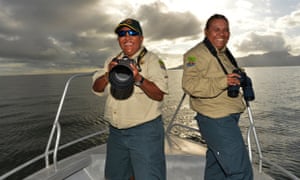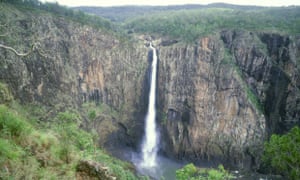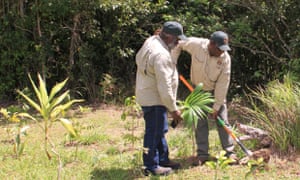Published: 7 Dec 2015

From The Guardian, Helen Davidson
The mammoth task of protecting a huge area of land and sea, as well as fighting to keep local languages and traditions alive, is all in a day’s work for Girringun’s extraordinary rangers
On an early midweek morning, half a dozen khaki-clad Indigenous rangers patrol the still waters between Cardwell and Hinchinbrook Island in far north Queensland. Several large sea turtles and a couple of dugongs surface, but there’s no sign of the resident crocodile which does laps of the coastline between here and Mission Beach to the north. There had been discussion about relocating the animal, but it was decided “better the devil you know” since his inevitable replacement might be more inclined to come ashore looking for food.
The rangers are from the Girringun Aboriginal Corporation, a trailblazing organisation which is educating and encouraging the next generation to help take care of a unique 1.2m hectare environmental protectorate area.
As well as running numerous programs including an arts centre, cultural museum, and community development programs, Girringun co-manages the enormous land and sea area under the region’s first Indigenous protected area agreement (IPA).
Its success over almost 20 years has seen Girringun shortlisted for the Indigenous Governance Awards, and this week members presented their years of work to a team of visiting judges.
At the beginning of the two-day site visit which Guardian Australia attended, chairman of the awards, Professor Mick Dodson, tells the members and employees assembled that he and the other judges are “here to be convinced”.
Girringun – now a fully incorporated not-for-profit organisation – was established in 1996, and represents around 650 traditional owners across nine traditional groups – Bandjin, Djiru, Girramay, Gugu Badhun, Gulnay, Jirrbal, Nywaigi, Warrgamay and Warungnu. A representative from each group sits on the board.
The organisation began as the dream of the current chief executive, Phil Rist, and two friends who objected to the naming of the local land.
As Rist tells it, the naturalist and broadcaster David Attenborough stood at Kennedy Falls in 1994 and proclaimed the surrounds Lumholtz national park. Norwegian explorer Carl Lumholtz had authored a book, Among Cannibals, in the late 1800s about his experiences living with Aboriginal people.
Rist tells Guardian Australia he dreamed of standing in the same spot as Attenborough did, and changing the name so it represented the local people and traditional owners, not an explorer who Rist said often described Indigenous people as the lowest form of humans.
“It was probably appropriate for the day but not now – we didn’t want our country named after this fella,” Rist says.
It took almost a decade, but the different traditional owner groups successfully campaigned for the land to be renamed the Girringun national park.
“It was the seed that united all those groups, and that seed has really grown into being the leading Indigenous land and sea centre in Queensland,” Rist says.

Girringun rangers Cindy-Lou Togo and Evelyn Ivey on patrol off the coast of Cardwell, Queensland. Photograph: Wayne Quilliam /Reconciliation Australia
Girringun works in cooperation with Queensland Parks and Wildlife Service, the Great Barrier Reef Marine Park Authority, WWF, and numerous other government and independent bodies in protecting and maintaining the environment under the IPA. The work takes them into bushland, rainforest, rivers and the sea.
Rangers also attend local schools, passing knowledge of plants, animals and environmental care on to Indigenous and non-Indigenous kids, and now have more than 40 signed up as part of the junior ranger program.
Under the sea management program, ranger teams conduct beach cleanups, including logging the amount of debris, and are the first responders for beached or injured marine life. The population and spread of seagrass and marine life including dugongs and turtles, is also closely monitored.
The rangers also administer the region’s traditional use of marine resources agreement, established by the six saltwater traditional owner groups of the Girringun region to authorise traditional hunting of marine turtles and dugong, under strict conditions.
Daniel Beeron works within the revegetation program, collecting seeds from nearby areas and cultivating them at the Cardwell nursery, before taking them back out to areas of rainforest in need of regeneration.
“Probably [after] about a week or so you see those little shoots come up and I’m down here [in the nursery] and I’m waiting and looking, until I see one and then I start smiling. Someone walks past and wonders why I’m smiling,” he says, laughing.
“The trouble is then you have to see them go into reveg. I like to make sure they’re in a good state – but [it’s like] letting my kids go.”
At a site just a short drive to the north of Cardwell, amid canefields and hills, Beeron and three fellow rangers plant figs, ginger and Herbert River Cherry plants by a creek in a small regenerated rainforest area. The land is a unique addition to the Indigenous protection area, granted to Girringun by the freehold owner, who has 50 acres, but decided the conservation area would be better cared for by traditional owners.
“That’s an extraordinary partnership,” says Dodson after the visit. “For a freeholder to do that speaks volumes for the organisation.”
Around a bend in the road is where traditional owner and Girringun board member, Claude Beeron, also Daniel’s father, grew up in the 1940s and 50s. Back then it was flat pasture with a few houses. Now it is a lush, regenerated rainforest, surrounding a burial site for Beeron’s relatives and other local Indigenous “old people”. Before entering, Beeron reassures the old people about why the group, including Guardian Australia, are there and tells them not to worry.

Wallaman falls in Girringun, far north Queensland. Photograph: Ted Mead/Getty Images
The history of Beeron’s family and people is a mixed one. While he says the time he grew up in was a happy one, scores of his people were killed in the massacres of the frontier wars, and older members of his family were forcibly removed to the Palm Island settlement. His father and grandparents were in chains.
“I’m a great believer in that when old people pass on their spirit is still here,” he tells Guardian Australia. “When you talk to someone else they feel a bit scared at night when you tell them about what happened many years ago. This place had some massacres. They were shooting people from the Ingham range back this way all the way up to Mission Beach.”
“We are the last few people [in the region] who still hold the knowledge of the language,” he says.
Beeron speaks two local Indigenous languages, and has made sure his children and grandchildren also speak them. He says the community created by the Girringun centre, particularly with local artists regularly coming in to work together, is the secret to Girringun’s success.
“When you’ve got a heap of people, like the artists here, that talk every minute and every day in their language in their workplace, I think that’s what’s important and keeps this organisation floating,” he says.
Girringun has ambitious plans to expand, including extending the protection area to cover rivers in the region, but is held back by having to rely on government funding which can’t be counted on for more than a few years at a time.
Situated between two large town centres – Cairns and Townsville – the Girringun region has no local resources sector to profit from, which has forced the organisation to think outside the box and focus on long-term strategies to ensure its sustainability and future economic independence.
“We’re between two massive world heritage areas – the wet tropics rainforest and the Great Barrier Reef marine park just off our doorstep here,” Rist says.
“How do we remain viable in that environment? If we were in central Queensland where there is massive mining happening we would be getting huge royalties coming in.
“Thankfully we haven’t got that but it’s taught us to be a lot more strategic about how we acquire funding for the organisation, given that we don’t have the opportunity for economic development like that.”
Dodson, who was also Australia’s first Aboriginal and Torres Strait Islander human rights commissioner, praises the work of the organisation, but says they are in a difficult financial environment.
“What I’ve seen in 10 years of being on the judging panel for the governance awards is that people marshal resources in all sorts of ways, and that’s really at the heart of good leadership and vision,” he tells Guardian Australia in Cardwell.
“It’s what leaders do, I think, leaders make things happen. That’s very evident here at Girringun, they’ve got good leadership across the board.”

Girringun rangers plant native species as part of the revegetation program run by the Girringun Aboriginal Corporation in Cardwell. Photograph: Helen Davidson/Guardian Australia
For the time being Girringun relies primarily on government funding from state and federal programs.
“Most Indigenous peoples and their organisations do very well in what’s a very difficult environment. Many have had to be reliant on government funding, but so too are many other Australians,” says Dodson.
“Particularly [for] our people who live in regional and remote areas, it’s much more difficult to get services in those places and that’s costly. It’s through Aboriginal organisations that people can get those things done, because nobody else is doing it.”
Varying funding arrangements mean there is little consistency across the programs Girringun runs. The rangers are partially funded by the federal “working on country” initiative and the Queensland Indigenous land and sea ranger program.
“The state money is from year to year and the working on country money is through to 2018,” Sean Walsh, Girringun’s rangers coordinator tells Guardian Australia.
“Beyond that we hope to try and achieve a few more successful grants, but might have to try and look at other avenues as well,” he says, suggesting seeking philanthropic support was on the cards.
“It would be great [to have long term funding] but this last lot of funding … with the ranger program, has been great for even a five-year length of time. But nothing seems to be certain these days in state or federal government.”
With such short timelines on some aspects of funding, plans can’t be as ambitious as Girringun members would like them to be. Numbers swelled in the days after cyclone Yasi devastated the town in 2011, as rangers from up and down the coast and inland country areas turned up to help rebuild, but now just 12 work across the protection area.
The success of the Girringun program means many more people would like to be involved but there is not yet enough capacity to take them on. Building up their ranger program is a “mammoth task”, Dodson says.
“We had a conversation with some of the rangers. They absolutely love their job. They particularly like getting out on country and taking kids out on country,” he says.
“I can think of quite a few people around the country emulating what Girringun’s doing, trying to build on their experience and their knowledge and ways of doing things. They could learn a lot from what Girringun’s done.”
He adds: “The [Indigenous governance] awards have got, for me at least, a number of functions. First and foremost is to celebrate peoples success in governance, and not just celebrate but to honour what they’ve done and scream that from the rooftops. It’s not only a source of pride for people but also they constitute role models that others will emulate.”
Girringun will learn if it is the winner of the prestigious award and a $20,000 prize at the end of next month.
